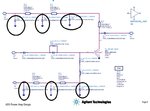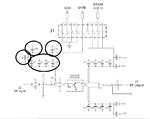f_t
Member level 4

Hello,
I am designing a Class-E power amplifier. As I looking at these circuits there are some capacitors on the root of biasing transistors. Could you please say why these capacitors have been used and how we should calculate their value to use them in our circuits?
I have attached two circuits. The first one is from Agilent and the other one
 is from Cree.
is from Cree.
Thanks a lot
I am designing a Class-E power amplifier. As I looking at these circuits there are some capacitors on the root of biasing transistors. Could you please say why these capacitors have been used and how we should calculate their value to use them in our circuits?
I have attached two circuits. The first one is from Agilent and the other one

 is from Cree.
is from Cree.Thanks a lot


